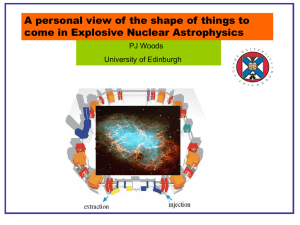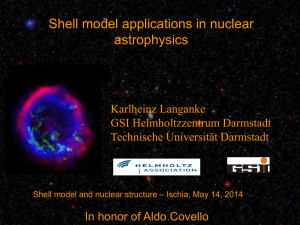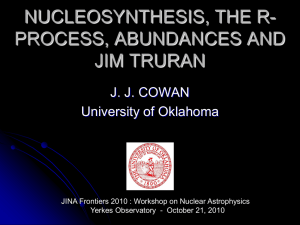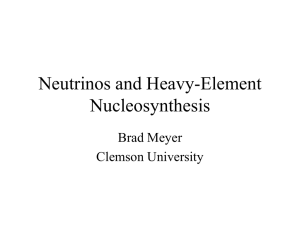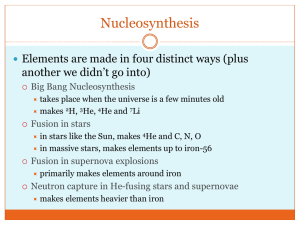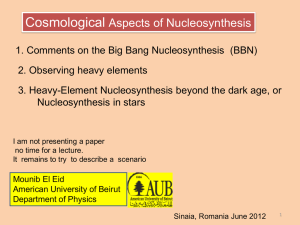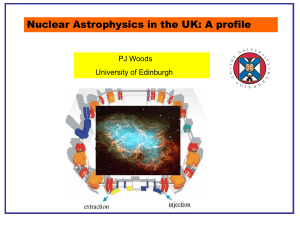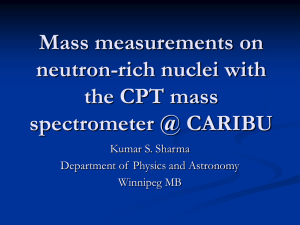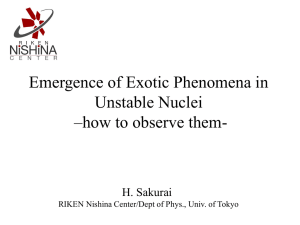Astrophysical, observational and nuclear
advertisement
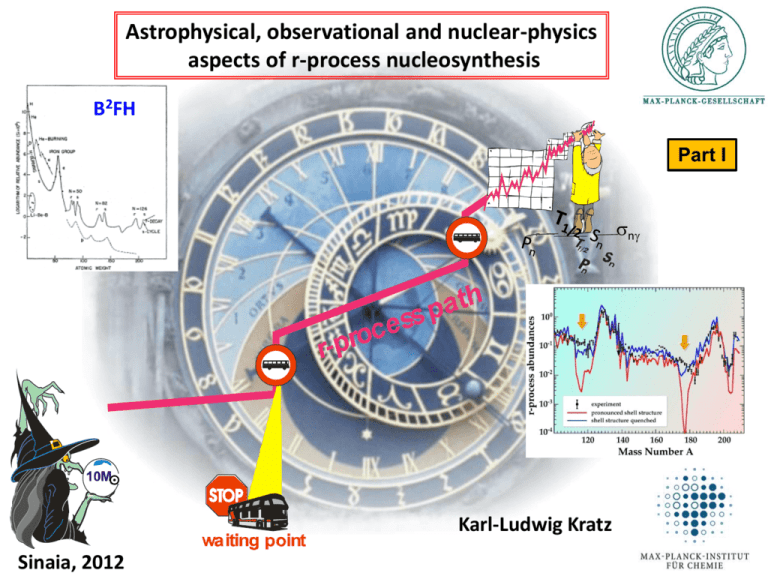
Astrophysical, observational and nuclear-physics aspects of r-process nucleosynthesis B2FH Part I sng Karl-Ludwig Kratz Sinaia, 2012 Some early milestones 1859 1932 first spectral analysis of the sun and stars by Kirchhoff & Bunsen “chemistry of the cosmos” discovery of the previously unknown neutron by Chadwick 1937 first systematic tabulation of solar abundances by Goldschmidt 1957 fundamental paper on nucleosynthesis by Burbidge, Burbidge, Fowler & Hoyle (B2FH) Rev. Mod. Phys. 29, 547 (1957) B²FH, the „bible“ of nuclear astrophysics Historically, nuclear astrophysics has always been concerned with • interpretation of the origin of the chemical elements from astrophysical and cosmochemical observations, • description in terms of specific nucleosynthesis processes. …55 years ago: Solar abundance observables at B²FH (1957) (Suess and Urey, 1956) „…it appears that in order to explain all the features of the abundance curve, at least eight different types of synthesizing processes are demanded…“ 1. H-burning 2. He-burning 3. -process 4. e-process 5. s-process 6. r-process 7. p-process 8. x-process neutrons Neutron-capture paths for the s- and r-processes Neutrons produce ≈75% of the stable isotopes, but only 0.005% of the total SS abundances…. s- and r-abundances today about equal H 30,000 C Fe Au 10 1 2·10-7 (from “Cauldrons in the Cosmos”) r-Process observables today Observational instrumentation Solar system isotopic Nr, “residuals” • meteoritic and overall solar-system abundances T9=1.35; nn=1020 - 1028 Pb,Bi • ground- and satellite-based telescopes like Imaging Spectrograph (STIS) at Hubble, HIRES at Keck, and SUBARU • recent „Himmelsdurchmusterungen“ HERES and SEGUE r-process observables CS 22892-052 abundances scaled solar r-process scaled theoretical solar r-process Zr Ru Cd Sn Ga Sr Mo Pd Ge Ba Nd Dy Gd Ce Sm ErYb Ir Hf Y Rh Nb Ag Presolar SiC grains and nano-diamonds e.g. isotopic composition of heavy metals Zr, Mo, Ru, Te, Xe, Ba, Pt Pt Os Pb La Eu Ho Pr Tb Lu Tm Au Th U Elemental abundances in UMP halo stars Isotopic anomalies in meteoritic samples and stardust Fit of Nr, from B²FH „Static“ calculation Reproduction of Solar system isotopic r-process abundances (mainly from r-only nuclei) • assumptions iron seed (secondary process) „waiting-point“ concept (global (n,g) (g,n) and ß-flow equilibrium) instantaneous freezeout The "waiting-point"concept in astrophysics (1) Rate of n-captures: (1) cross section averaged over MaxwellBoltzmann velocity distribution to T9 Photodisintegration: (2) Nuclear Saha equation The "waiting-point"concept in astrophysics (2) Nuclear Saha equation: simplified • high nn • low Sn • low T "waiting-point" shifted to higher masses "waiting-point" shifted to higher masses "waiting-point" shifted to higher masses Equilibrium-flow along r-process path: - governed by β-decays from isotopic chain Z to (Z+1) T1/2 ("w.-p.") ↔ Nr,ʘ Fit of Nr, from B²FH „Static“ calculation Reproduction of Solar system isotopic r-process abundances (mainly from r-only nuclei) • assumptions iron seed (secondary process) „waiting-point“ concept (global (n,g) (g,n) and ß-flow equilibrium) instantaneous freezeout • astrophysical conditions explosive He-burning in SN-I T9 1 (constant) nn 1024 cm-3 (constant) r 100 s • neutron source: 21Ne(,n) Seeger, Fowler & Clayton, ApJ 98 (1965) Speculations about r-process scenario: SN-I (as in B2FH) unlikely Explosion of massive stars M > 104 Mʘ Conventional SNe Speculations about various r-process components: "short-time" solution 0.44 s 1.77 s 3.54 s Cycle time: 4.9 s "long-time" solution …however, all components with the same neutron-density of 1024 n/cm3 ! r-Process scenarios since B2FH For long time suspect, that puzzle of r-process site is closely intertwined with puzzle of SN explosion mechanism (see e.g. Reviews by Hillebrandt 1978; Meyer & Brown 1997) …original papers "core-collapse SN", e.g. Bethe & Wilson (1985); Mayle & Wilson (1988, 1991); …first papers "neutrino-driven winds", e.g. Duncan, Shapiro & Wasserman (1986); Woosley & Hoffman(1992); Takahashi, Witti & Janka (1994). …other suggested scenarios: - He-core flashes in low-mass stars He- and C-shells of stars undergoing SN explosions Neutron-star mergers Black-hole neutron-star mergers Hypernovae Electron-capture SNe r-Process without excess neutrons Gamma-ray bursts SNe with active-sterile neutrino oscillations Jets of matter from collapse of rotating magnetized stellar cores …becoming more and more "exotic" Fit of Nr, from B²FH „Static“ calculation Reproduction of Solar system isotopic r-process abundances (mainly from r-only nuclei) • assumptions iron seed (secondary process) „waiting-point“ concept (global (n,g) (g,n) and ß-flow equilibrium) instantaneous freezeout • astrophysical conditions explosive He-burning in SN-I T9 1 (constant) nn 1024 cm-3 (constant) r 100 s • neutron source: 21Ne(,n) • nuclear physics: Q − Weizsäcker mass formula + empirical corrections (shell, deformation, pairing) T1/2 – one allowed transition to excited state, logft = 3.85 Parameter checks Fitting r-process abundances: a nuclear-structure learning effect or discussing the fifth leg of an elephant ? • Do r-abundance deficiencies disappear when changing the nuclear-physics input ? • Can effects of masses (Sn) and T1/2 & Pn be studied separately ? • To what extent is the "waiting-point" assumption valid ? keep it simple ! Nuclear-data needs for the classical r-process nuclear masses Sn-values r-process path / “boulevard” Q, Sn-values theoretical -decay properties, n-capture rates -decay properties T1/2 r-process progenitor abundances, Nr,prog -decay Pn smoothing Nr,prog freeze-out Nr,final (Nr,) modulation Nr through re-capture neutron capture rates sRC + sDC smoothing Nr,prog during freeze-out in “non-equilibrium” phase(s) fission modes SF, df, n- and n-induced fission “fission (re-) cycling”; r-chronometers nuclear structure development - level systematics - “understanding” -decay properties - short-range extrapolation into unknown regions Nuclear masses Over the years, development of various types of mass models / formulas: • Weizsäcker formula • Local mass formulas (e.g. Garvey-Kelson; NpNn) • Global approaches (e.g. Duflo-Zuker; KUTY) • Macroscopic-microscopic models (e.g. FRDM, ETFSI) • Microscopic models (e.g. RMF; HFB) Comparison to NUBASE (2001) // (2012) FRDM (1995) srms = 0.669 // 0.564 [MeV] ETF-Q (1996) srms = 0.818 // 0.729 [MeV] HFB-2 (2002) srms = 0.674 [MeV] HFB-3 (2003) srms = 0.656 [MeV] HFB-4 (2003) srms = 0.680 [MeV] HFB-8 (2004) srms = 0.635 [MeV] HFB-9 (2005) srms = 0.733 [MeV] HFB-21 (2011) srms = 0.577 [MeV] No significant improvement of srms J. Rikovska Stone, J. Phys. G: Nucl. Part. Phys. 31 (2005) Main deficiencies at Nmagic and in shape-transition regions ! D. Lunney et al., Rev. Mod. Phys. 75, No. 3 (2003) Nuclear masses effect of Sn around N=82 shell closure catchword “shell-quenching” astrophys. parameters (T9, nn, τn) and T1/2 kept constant “static” calculations (Saha equation) break-out at N=82 130Cd K.-L. Kratz et al. Nucl. Phys. A630 (1998) “time-dependent” calculations (w.-p.) r-matter flow at A=130 peak B. Pfeiffer et al. Nucl. Phys. A693 (2001) Effects of N=82 "shell quenching" Single – Neutron Energies (Units of h w0) "Shell quenching" N/Z g 9/2 126 7.0 g 9/2 p 1/2 f 5/2 p 3/2 112 h 9/2 ;f 5/2 p 1/2 i 13/2 6.5 h 9/2 f 7/2 p 3/2 f 7/2 82 6.0 5.5 70 h 11/2 g 7/2 h 11/2 g 7/2 d 3/2 d 3/2 s 1/2 s 1/2 d 5/2 d 5/2 50 5.0 i 13/2 g 9/2 g 9/2 40 p 1/2 f 5/2 …reduction of the spin-orbit coupling strength; caused by strong interaction between bound and continuum states; due to diffuseness of "neutron-skin" and its influence on the central potential… • high-j orbitals (e.g. nh11/2) • low-j orbitals (e.g. nd3/2) • evtl. crossing of orbitals • new “magic” numbers / shell gaps (e.g. 110Zr70, 170Ce112) f 5/2 p 1/2 100% 70% 40% 10% Strength of ℓ 2 -Term B. Pfeiffer et al., Acta Phys. Polon. B27 (1996) change of • shell-gaps • deformation • r-process path (Sn) • r-matter flow (τn) The N=82 shell gap as a function of Z The N=82 shell closure dominates the matter flow of the „main“ r-process (nn ≥ 1023). Definition „shell gap“: S2n(82) – S2n(84) ↷ paired neutrons. Therefore request: experimental masses and reliable model predictions for the respective N=82 waiting-point nuclei 125Tc to 131In A≈130 N peak r, FRDM Exp DZ Groote EFTSI-Q Exp HFB-14 N=82 shell-quenching FRDM “trough” WARNING: FRDM not appropriate for r-process calculations ! Deviation from SS-r: FRDM vs. ETFSI-Q How to fill up the FRDM A 115 “trough” ? • if via T1/2 (as e.g. suggested by Nishimura, Kajino et al.; PRC 85 (2012)), on average all r-progenitors between 110Zr and 126Pd should have 7.5 x T1/2(FRDM) 350 ms → 2 x T1/2(130Cd) at top of r-peak • it must be the progenitor masses, via Sn (and correlated deformation ε2) Nuclear-data needs for the classical r-process nuclear masses Sn-values r-process path / “boulevard” Q, Sn-values theoretical -decay properties, n-capture rates -decay properties T1/2 r-process progenitor abundances, Nr,prog -decay Pn smoothing Nr,prog freeze-out Nr,final (Nr,) modulation Nr through re-capture neutron capture rates sRC + sDC smoothing Nr,prog during freeze-out in “non-equilibrium” phase(s) fission modes SF, df, n- and n-induced fission “fission (re-) cycling”; r-chronometers nuclear structure development - level systematics - “understanding” -decay properties - short-range extrapolation into unknown regions Effects of T1/2 on r-process matter flow Mass model: ETFSI-Q T1/2 (GT + ff) - all astro parameters (T9, nn, τn) kept constant r-Process model: “waiting-point approximation“ T1/2 x 3 r-matter flow too slow T1/2 : 3 r-matter flow too fast 130Cd – the key isotope at the A=130 peak …hunting for nuclear properties of waiting-point isotope 130Cd… already B²FH (Revs. Mod. Phys. 29; 1957) C.D. Coryell (J. Chem. Educ. 38; 1961) 132Sn 50 131 (n,g) 134 135 136 132 133In 84 49 134 135 132 133 133 Pn~85% “climb up the staircase“ at N=82; major waiting point nuclei; “break-through pair“ 131In, 133In; “association with the rising side of major peaks in the abundance curve“ r-process path (n,g) 130 131In 82 49 129 130Cd 82 48 131 128 129Ag 82 47 130 127 128Pd 82 46 126 127Rh 82 45 (n,g) K.-L. Kratz (Rev. Mod. Astr. 1; 1988) climb up the N= 82 ladder ... A 130 “bottle neck“ T1/2(130Cd) Nr,ʘ(130Te) ? 137 "Waiting-point" estimate T1/2(130Cd) If the historical "waiting-point" concept is valid for the A ≈ 130 Nr,ʘ-peak, then in the simplest version with Sn(N=82)=const. From this assumption, in 1986 the waiting-point prediction for T½(130Cd) ≈ 595 ms. With a more realistic approach, taking into account that • • the breakout from N=82 involves 131In und 133In (≈ 1:1) 133In has a known P ≈ 90% n …to be compared to the 1986 exp. value of 195 (35) ms, and to the 2001 improved value of 162 (7) ms. Nuclear models to calculate T1/2 Theoretically, the gross β-decay quantities, T1/2 and Pn, are interrelated via the so-called β-strength function [S(E)] “Theoretical” definition (Yamada & Takahashi, 1972) “Experimental” definition (Duke et al., 1970) S(E) = D-1 · M(E) ² · w(E) [s-1MeV-1] M(E) average -transition matrix element w(E) level density D const., determines Fermi coupling constant gv² T1/2 = 106 103 b(E) absolute -feeding per MeV, f(Z, Q-E) Fermi function, T1/2 -decay half-life. i 6x105 i f(Z, Q-Ei) (Q-Ei)5 1,E+05 1,E+04 [s-1MeV-1] S (E ) x f (Z,Q -E ) 0Ei Q 1,E+06 f(Z, Q-E) · T1/2 1 T1/2 as reciprocal ft-value per MeV S(E) b(E) S(E) = 3x103 Fermi function T1/2 sensitive to lowest-lying resonances in S(Ei) Pn sensitive to resonances in S(Ei) just beyond Sn 1,E+03 1,E+02 Q same T1/2 ! 1,E+01 ↷ easily “correct” T1/2 with wrong S(E) 1 1 1 11,E+00 1,E-01 1 1 2 3 4 5 5 6 7 8 9 10 10 E*[MeV] T1/2 and Pn calculations in 3 steps – (I) “Typical spherical example”: (1) Mass model FRDM ↷ Q, Sn, e2 Folded-Yukawa wave fcts. SP shell model QRPA (pure GT) with input from FRDM potential: Folded Yukawa pairing-model: Lipkin-Nogami SnQ (2) as in (1) with empirical spreading of SP transition strength, as shown in experimental S(E) (3) as in (2) with addition of first-forbidden strength from Gross Theory note: effects on T1/2 and Pn ! T1/2 and Pn calculations in 3 steps – (II) …and a typical “deformed” case: spreading of SP strength to deformed “Nilsson spaghetti” Möller, Nix & Kratz; ADNDT 66 (1997) Möller, Pfeiffer & Kratz; PRC 67 (2003) Note: low-lying GT-strength; ff-strength unimportant! Pn effects at the A≈130 peak Significant differences (1) smoothing of odd-even Y(A) staggering (2) importance of individual waiting-point nuclides, e.g. 127Rh, 130Pd, 133Ag, 136Cd (3) shift left wing of peak Global T1/2 & Pn – calc. vs. exp. T1/2, Pn gross -strength properties from theoretical models, e.g. QRPA in comparison with experiments. Requests: (I) prediction / reproduction of correct experimental “number” (II) full nuclear-structure understanding ↷ full spectroscopy of “key” isotopes, like 80Zn50 , 130Cd82. Total Error = 3.73 Half-lives QRPA (GT) Total Error = 5.54 Pn-values QRPA (GT) QRPA (GT+ff) QRPA (GT+ff) (Möller, Pfeiffer, Kratz PR C67, 055802 (2003)) Total Error = 3.08 Total Error = 3.52 Nuclear-data needs for the classical r-process nuclear masses Sn-values r-process path / “boulevard” Q, Sn-values theoretical -decay properties, n-capture rates -decay properties T1/2 r-process progenitor abundances, Nr,prog -decay Pn smoothing Nr,prog freeze-out Nr,final (Nr,) modulation Nr through re-capture neutron capture rates sRC + sDC smoothing Nr,prog during freeze-out in “non-equilibrium” phase(s) fission modes SF, df, n- and n-induced fission “fission (re-) cycling”; r-chronometers nuclear structure development - level systematics - “understanding” -decay properties - short-range extrapolation into unknown regions E(2+) - landscape 90 A 150 Z E(2+) • reduced pairing • rigid rotors • ng7/2 pg9/2 interaction • shell quenching 90Zr 132Sn 96Zr 50 nd5/2 56 110Zr 60 ns1/2 ng7/2 nh11/2 • magic shells/subshells • shape transitions/coexistence • intruder states • identical bands nd3/2 50 82 pg9/2 40 N What is known experimentally ? Known 1+ states in n-rich even-A In isotopes 1+ OXBASH (B.A. Brown, Oct. 2003) 1+ 2120 2181 (new) 1+ 3+ 243 0 124In 75 1+ 688 3+ 0 126In 77 1731 keV 1+ 1173 3+ 0 128In 79 1382 (old) Reduction of the TBME (1+) by 800 keV 3+ 389 3+ 473 1- 0 1- 0 130In Configuration 1- : nh11/2 pg9/2 Configuration 3+ : nd3/2 pg9/2 Configuration 1+ : ng7/2 pg9/2 1+ 81 130In 81 Dillmann et al.; PRL 91 (2003) determines T1/2 Short range extrapolation Known ! partly known S1n=5.246MeV S1n=3.98MeV Beta-decay odd-mass, N=82 isotones nSP states in N=81 isotones extrapolation E*[MeV] 3 ng7/2 2565 2,5 89% 4.0 7/2+ 2607 S1n=3.59MeV 88% 4.0 2 Pn=4.4% 1,5 7/2+ S1n=2.84MeV 2648 67% 264345% 4.1 0,5 ns1/2 nd3/2 0 524 P4n= 8.5% P5n= 1% 282 nh11/2 131Sn 81 50 2.3% 0 6.3 728 814 601 3/2+ 3/2+ 1/2+ 331 11/2- 129Cd 81 48 1.2% 6.3 3/2+ 414 11/2127Pd 81 46 0.9% 6.4 472 11/2125Ru 81 44 4.5 S1n=1.81MeV 1 1/2+ 263724% P1n=25% P2n=45% P3n=11% T1/2 determined by Q-E7/2 1/2+ ng7/2 4.25 P1n=39% P2n=11% P3n= 4.5% P1n=29% P2n= 2% Pn=9.3% 7/2+ 0.6% 6.4 1/2+ 908 3/2+ 536 11/2123Mo 81 42 0.5% I 6.45 log(ft) Surprising -decay properties of 131Cd …just ONE neutron outside N=82 magic shell Experiment: T1/2 = 68 ms; Pn = 3.4 % QRPA predictions: T1/2(GT) = 943 ms; T1/2(GT+ff) = 59 ms; Pn(GT) = 99 % Pn(GT+ff) = 14 % nuclear-structure requests: higher Qβ, main GT lower, low-lying ff-strength; later, g-spectroscopic confirmation of decay scheme at ISOLDE The FK2L waiting-point approach (I) e.g.: Cameron, Clayton, Schramm, Truran, Kodama, Arnould, Woosley, Hillebrandt, Thielemann… 30 known r-process isotopes at that time: N=50 79Cu, 80Zn, 81Ga N=82 130Cd, 131In The FK2L waiting-point approach (II) Classical assumptions: global steady flow of r-process through N=50 80Zn, N=82 130Cd and N=126 195Tm Calculation: r-process matter flow at freeze-out temperature ; at N=82 “imperfect” peak, r-process through 40 s 132Sn, instead of 195 ms 130Cd… The FK2L waiting-point approach (III) The FK2L waiting-point approach (IV) “…best fit so far…; long-standing problem solved…” W. Hillebrandt “…call for a deeper study… before rushing into numerical results… and premature comparisons with the observed abundances” M. Arnould birth of N=82 “shell-quenching” idea … Wide-spread ignorance of experimental r-process data Two typical examples: I. Dillmann & Y.A. Litvinov Prog. Part. Nucl. Phys. 66 (2011) “Up to now, one could only “scratch” the regions where the r-process takes place.” M.R. Mumpower, G.C. McLaughlin & R. Surman Ap.J. 752 (2012) “…current experimental data on neutron-rich isotopes is sparse.” But …”recent developments using radioactive beams show promise [ Hosmer et al. (2005) 78Ni; Jones et al. (2009) 132Sn ].” History and progress in measuring r-process nuclei Already 26 years ago, in 1986 a new r-process astrophysics era started: • at the ISOL facilities OSIRIS and TRISTAN T1/2 of N=50 “waiting-point” isotope 540 ms 80Zn (top of A ≈ 80 Nr, peak) • at the ISOL facility SC-ISOLDE T1/2 of N=82 “waiting-point” isotope 195 ms 130Cd (top of A ≈130 Nr, peak) Both act as major “bottle-necks” for the matter flow of the classical r-process starting from an Fe-group seed Experimental information on r-process nuclides Today, 82 altogether ≈ 80 r-process nuclei known g9/2 p1/2 p3/2 f5/2 f7/2 42 Z 86 Ba Cs Xe I Te Sb heaviest isotopes with measured T1/2 new (MSU, 2009; RIKEN 2011) Sn In Cd Ag Pd Rh Ru Tc Mo Nb Zr Y Sr Rb Kr Br Se As Ge Ga Zn Cu Ni Co Fe 84 N 44 46 g9/2 48 50 52 d5/2 54 56 58 s1/2 60 62 64 g7/2 66 68 d3/2 70 72 74 76 h11/2 78 80 82 88 90 92 94 nn Classical r-process path for nn=1020 =1020 82 Ba Cs Xe I Te Sb Sn In Cd Ag Pd Rh Ru Tc Mo Nb Zr Y Sr Rb Kr Br Se As Ge Ga Zn Cu Ni Co Fe 42 Z N 44 46 48 50 52 54 56 58 60 62 64 66 68 70 72 74 76 „waiting-point“ isotopes at nn=1020 freeze-out 78 80 82 84 86 88 90 92 94 nn Classical r-process paths for nn=1020 and 1023 =1020 82 84 86 88 90 92 94 Ba Cs Xe I Te Sb Sn In Cd Ag Pd Rh Ru Tc Mo Nb Zr Y Sr Rb Kr Br Se As Ge Ga Zn Cu Ni Co Fe nn=1023 42 Z N 44 46 48 50 52 54 56 58 60 62 64 66 68 70 72 74 76 78 80 82 „waiting-point“ isotopes at nn=1023 freeze-out (T1/2 exp. : 28Ni – 31Ga, 36Kr – 40Zr, 47Ag – 51Sb) nn r-Process paths for nn= 1020, 1023 and 1026 =1020 r-process “boulevard” 82 84 86 88 90 92 94 Ba Cs Xe I Te Sb Sn In Cd Ag Pd Rh Ru Tc Mo Nb Zr Y Sr Rb Kr Br Se As Ge Ga Zn Cu Ni Co Fe nn=1023 nn=1026 42 Z N 44 46 48 50 52 54 56 58 60 62 64 66 68 70 72 74 76 „waiting-point“ isotopes at nn= 1026 freeze-out (T1/2 exp. : 28Ni, 29Cu, 47Ag – 50Sn) 78 80 82 Summary “waiting-point” model seed Fe (still implies secondary process) superposition of nn-components …largely site-independent! T9 and nn constant; instantaneous freezeout “weak” r-process (later secondary process; explosive shell burning?) “main” r-process (early primary process; SN-II?) Kratz et al., Ap.J. 662 (2007)
